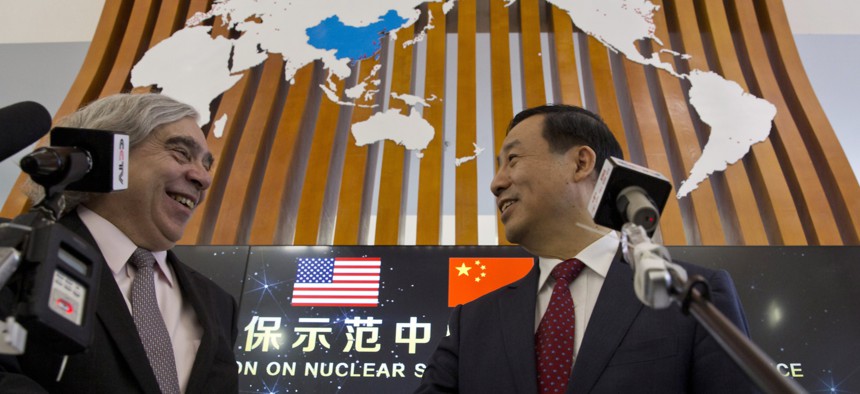
U.S. Secretary of Energy Ernest Moniz, left, and Chairman Xu Dazhe of the Chinese Atomic Energy Authority at the Nuclear Security Center of Excellence in Beijing on March 18, 2016. Ng Han Guan/AP
It's Time for China to Turn Nuclear-Security Pledges into Reality
Beijing's made a good start, but must buckle down before terror groups exploit corruption to devastating effect.
There is no shortage of terrorist groups – homegrown and international alike – that see opportunity in China’s nuclear enterprise, the fastest-growing in the world. Some would like to steal radioactive material for nuclear or dirty bombs; others may be pondering ways to breach a facility’s containment walls or even induce a Fukushima-style meltdown.
Beijing has shown an admirable willingness to work with the international community on issues of nuclear terrorism. Sparked by the international Nuclear Security Summits, which began in 2010, China has actively worked on new laws and regulations and has spent money to improve its nuclear facilities’ physical security, materials control, accounting, monitoring, and other equipment. A joint U.S.-China Center of Excellence on Nuclear Security was commissioned in Beijing last week, just ahead of Chinese President Xi Jinping’s arrival in Washington for the fourth and final summit, opening on March 31.
But more must be done. The nuclear industry and the government agenies that regulate and fund it are far from immune to the country’s well-known and widespread corruption. Indeed, several former nuclear-sector leaders are among the senior officials accused of bribery and abuse of power in the anti-corruption campaign that began in 2012. They include a former director of the National Energy Administration, which is the principal authority over nuclear power plants and responsible for drafting plant safety and security regulations; a former director of the nuclear power bureau under the NEA; a former general manager of the China National Nuclear Corporation; and a former vice-general manager of the China General Nuclear Power Group. Such charges raise the specter of insider theft of nuclear materials, unauthorized access to restricted areas, and conspiracy with other insiders or outsiders.
Among the groups that might be interested in such things is the East Turkestan Islamic Movement, which claimed responsibility for more than 200 acts of terrorism between 1990 and 2001. Since 2013 alone, ETIM has carried out more than 40 attacks that have killed several hundred people in total. Founded by extremist separatists in the predominantly Muslim Uighur community, ETIM has expanded its area of operations from the Xinjiang area to other large cities, including Beijing, Kunming and Guangzhou. Its targets, once mostly limited to government buildings and police stations, more recently have included train stations, supermarkets, and other civilian targets. And its weapons of choice have grown in sophistication from knives and axes to suicide vests, car bombs, grenades, and other explosives.
Even if ETIM itself has no designs on nuclear facilities, its allies likely do. Chinese authorities say the group’s members have long received training, financial assistance and support from al Qaeda. Its members often shelter in Pakistan and other Chinese neighbor states where nuclear smuggling and proliferation activities take place. Hundreds of Xinjiang’s Uighur Muslims are reported to be fighting alongside ISIS, the Islamic State, in the Middle East. Some, after training and actual combat experience, are known to have returned to China, presumably to prepare for attacks – but at least potentially, to seek radioactive or fissile material or even military nuclear weapons.
The entire planet has a major interest in China’s ability to deal with these problems. As former UN Secretary-General Kofi Annan warned, an act of nuclear terrorism would cause a global economic shutdown that would push millions into poverty and create a “second death toll in the developing world.” To his credit, Xi recognizes this. “The amount of water a bucket can hold is determined by its shortest plank,” the Chinese president said at the 2014 Nuclear Security Summit. “The loss of nuclear material in one country can be a threat to the whole world.” He pledged that China “will stay firmly committed to strengthening its own nuclear security capability” and “to building the international nuclear security system.”
But converting those promises into sustainable reality will require China to remedy vulnerabilities that range from nuclear regulatory arrangements to physical infrastructure to its security culture. Beijing should take further steps to install a complete, reliable and effective security system to ensure that all its nuclear weapons, weapon-usable nuclear materials, nuclear facilities and nuclear transports are effectively protected against the full spectrum of plausible terrorist and criminal threats.
China’s improvement in nuclear security has benefited greatly from international cooperation. China and the United States should now use the new Center of Excellence as a forum for best-practice exchanges, technical cooperation, research and development projects and personnel training. This bilateral cooperation should also expand to include more focused work in the defense sector that deals with nuclear weapons and the most sensitive nuclear materials, perhaps through lab-to-lab cooperation and exchanging visits at actual sites.
This could start with less sensitive sites, but the important thing is to start. The risks of inaction are increasing every day.
This post is part of a series published by Carnegie Corporation of New York about issues related to the 2016 Nuclear Security Summit in Washington, D.C., on March 31-April 1 to address the threat of nuclear terrorism. Visit Carnegie.org and join the conversation on Twitter at @CarnegieCorp, @BelferCenter, #NSS2016. The views expressed above are the author’s own.
NEXT STORY: The Changing Logic Behind Suicide Bombings